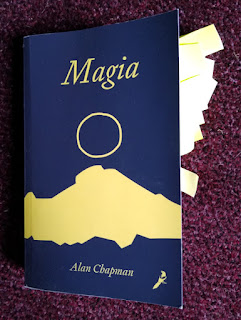Inbetween the Lines: Essays on Occulture, Magic, and Seductive Zombie Strippers by Carl Abrahamsson
As you probably know, Carl Abrahamsson is editor of The Fenris Wolf, the occasional occultural journal which has been blending magic(k), avant garde art and psychotherapy since 1989. Abrahamsson is a ferociously productive writer, whose output is nigh-impossible to keep up with with—essays, talks, films, books and more. He describes his approach as ‘anthropological’; he often frames occultural things as aspects of a more universal human quality or other.
In one of these essays, ‘The Magic of Dreams’, he tells us the overall frame of his magical life:
‘The key to a good life was (and is) simply to control your own time, and never flex away too much from the insight that Time is a currency strongly linked to our perception of freedom. True Will needs to be merged with Time, that’s a solid formula for successful magic.’
I can relate to that a lot. Being able to control one’s own time is the polar opposite of the corporate work nightmare that we are supposed to accept as normal, and its continuation is a major driver for my own magic.
Abrahamsson’s background includes inputs from TOPY, Thelema and the experiments of William Burroughs, techniques to wake up from the trance of Control. In the essay ‘On Source Magic’ he defines 'occulture' as the the ‘intersection between esoteric theory and practice and how underground streams move into the mainstream through the process of occulturation.’ This latter term is something of a theme in this volume.
Another main theme is in the title, which refers to his thoughts about forming sigils: the real writing is usually 'in between the lines’. He makes a strong analogy between cut-up, ritual and gnosis in the essay ‘Cut-Ups and Magic’.
In the piece ‘Anatal Digilog’ we get into secrecy and glamour. Mr A outlines some of the features of a group that can do art and magic together and survive in this era. ‘The inner network would therefore have to be tight and sealed … In a culture of debauched flaunting and catering to the most whimsical of vanities, concepts like silence, invisibility and darkness are very powerful soils. …’ This is not the secrecy of magical grifters and fake gurus but the Hermetic seclusion necessary for the gestation of magical art.
In ‘Climb the Heights’ he discusses sigilization and TOPY. In ‘Forcing the Hand of Chance’ he givers a ‘subjective’ history of TOPY. These were perhaps the most interesting essays for me. Not being close to the TOPY thing in the 1980s, it was history I was mostly unaware of. In that era TOPY and my own community, the IOT, were swimming in the same stream of cut ups and AOS, quite separately, and we had the older members. American IOT organizer Bob Williams in the 1990s described TOPY as ‘grade school for the IOT’.
Mr A describes in ‘Practice Makes Perfect’ the creation of an egregore, the Mega Golem, ‘a magical being consisting of art but not necessarily known or seen or heard at all’. He started the process by assembling body parts from texts and photos into a ‘literal corpus.’ Then he invited other artists to contribute, so it became a genuine egregore entity, something with many degrees of freedom derived from multiple inputs. This is a great example of egregore work.
Anyone who’s seen the Burroughs films Towers Open Fire and The Cut-Ups may know they were made by Antony Balch. That was the only thing I knew about him until I read ‘Balch, Burroughs and Gysin: Cinematic visions beyond the cut.’ There’s some subcultural history here, Genesis P Orage saving the few existing prints of Balch’s films ‘from destruction c/o a careless distributor of adult films who had shared offices with Balch at the time of his death in 1980.’
Whom would I recommend this book for? As far as the magical techniques are concerned, I was already familiar with all of that. Newcomers to practice may benefit, because these technical ideas are expressed in a non-dogmatic way with a leaning to art and culture.
The most interesting essays for me were on magical history, particularly that of TOPY and some aspects of William Burroughs’s oeuvre. I would strongly recommend the book for anyone who wants a personal, I-was-there, magically-aware view of those histories.




Comments
Post a Comment